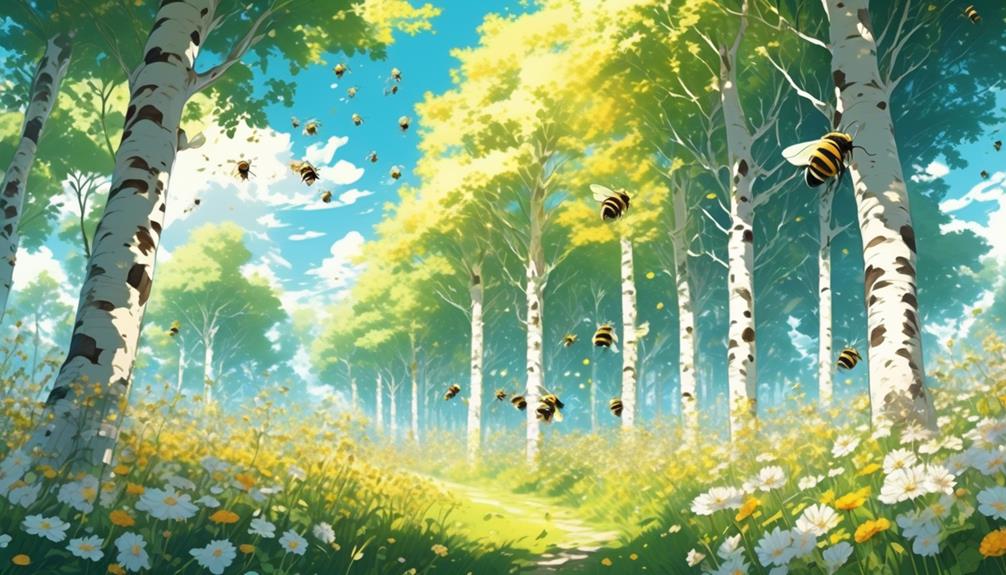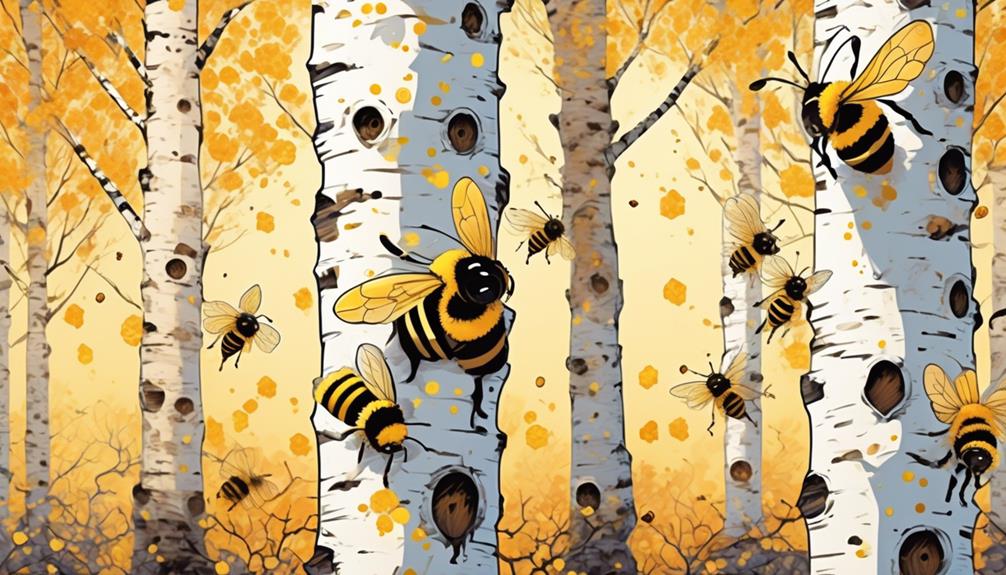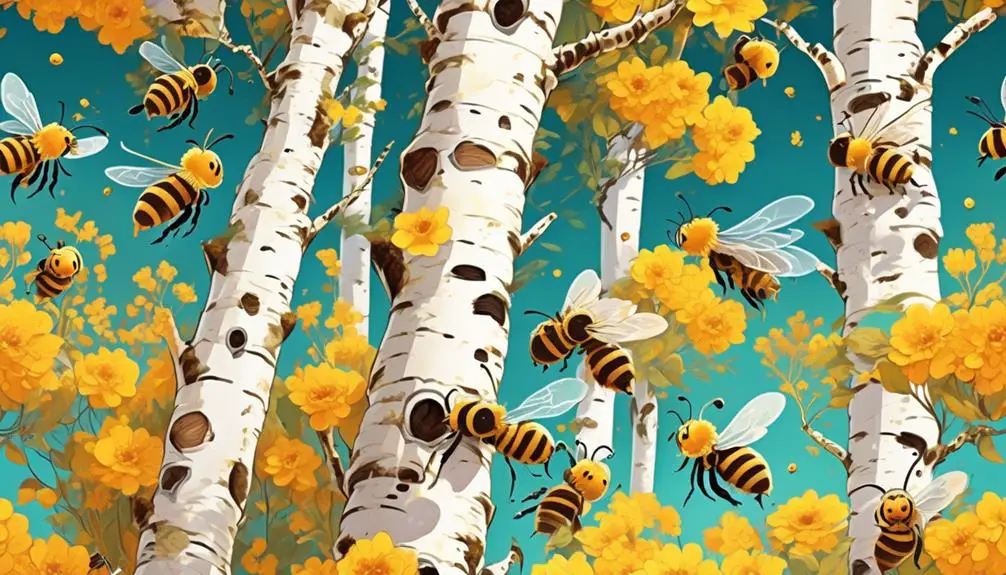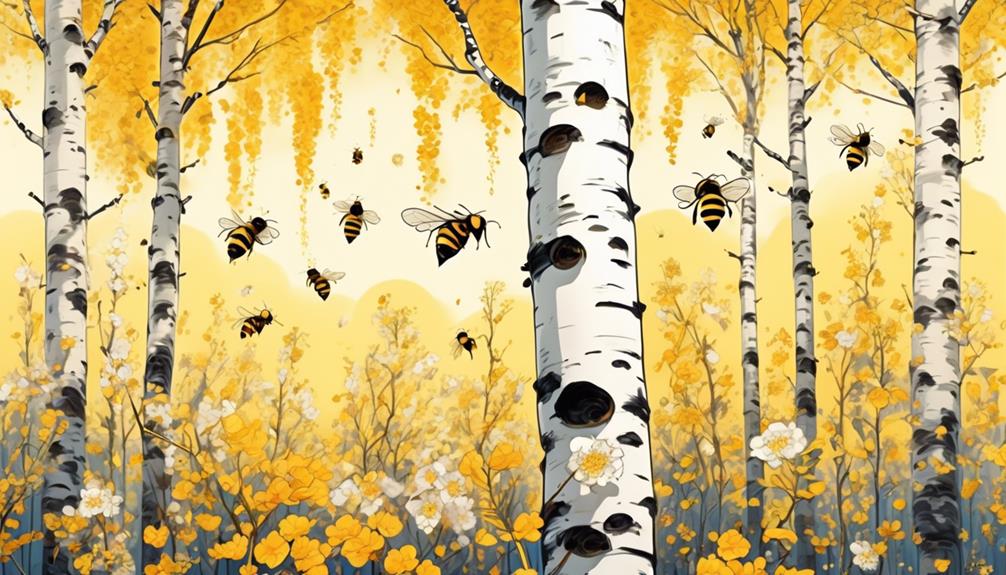Keeping bees buzzing, birch trees hold a surprising secret in the world of pollination; discover their untold connection.

Do Bees Like Birch Trees
Bustling bees and beautiful birch trees may not seem like the most obvious pairing in nature's grand design, but there's more to this relationship than meets the eye.
You've likely spent countless sunny afternoons watching bees flit from flower to flower, but have you ever stopped to consider what draws them to specific species of trees? It's a question that holds more significance than you might think, and the answers could provide invaluable insight into the intricate workings of our ecosystems.
As we explore this fascinating topic, you'll discover that the humble birch tree may have a bigger role to play in the lives of bees than you ever imagined. Stay tuned, and you'll find out just how deep this rabbit hole goes.
Key Takeaways
- Bees are attracted to birch trees due to the rich source of nourishment they provide through pollen and sap.
- Birch trees rely on bees for cross-pollination, which enhances genetic diversity and the long-term survival of birch populations.
- Bees unintentionally enhance cross-pollination in birch trees, resulting in offspring with superior resilience.
- The relationship between bees and birch trees is a complex interplay of ecological factors, highlighting the importance of their mutual dependency for reproductive success and overall health.
Understanding Bee Preferences

To truly comprehend why bees might gravitate towards birch trees, it's essential to dive deep into their unique preferences and behaviors. As an observer, you'd notice that bees don't randomly buzz from flower to flower. They're meticulous in their choices, guided by intricate factors such as color, scent, shape, and nectar concentration.
Through scientific research, it's been established that bees possess an exceptional affinity for certain colors. They're particularly drawn to flowers with blue, purple, and yellow hues. If you've ever noticed a bee hovering around your lavender or sunflower plants, now you know why. Scent too plays a pivotal role. Bees have an extraordinary sense of smell, which they utilize to locate flowers rich in nectar.
Now, consider the shape of the flower. Bees prefer flowers that provide a landing platform, making the extraction of nectar easier. Lastly, bees seek out flowers with a high nectar concentration, as it's their primary food source. Understanding these preferences provides insight into why bees might be attracted to birch trees, whose catkins are rich in pollen, providing an ample food source.
Overview of Birch Trees

Let's turn our attention to birch trees, a diverse family of deciduous hardwood trees known for their distinct bark and slender branches. They belong to the Betulaceae family and the Betula genus, which comprises around 60 different species. These trees are native to temperate and boreal climates across the Northern Hemisphere.
Birch trees stand out with their unique bark characteristics. It's typically white or silver, peeling in horizontal strips, and often marked with horizontal lenticels – small raised areas allowing gas exchange between the tree and its environment. You'll often find birch trees in moist environments near ponds, lakes, and streams where they can access plenty of water.
You'll recognize birch trees by their oval or triangular leaves, which turn a vibrant yellow in the fall. They're monoecious, meaning a single tree bears both male and female flowers, known as catkins. In spring, these catkins produce wind-dispersed pollen, vital for the tree's reproduction, but also a potential attractant for bees.
Understanding birch trees' characteristics will help us delve deeper into the relationship between these trees and bees. It's crucial to consider their biology and ecology when assessing their attractiveness to bees.
Bees and Birch Trees: The Connection

In examining the connection between bees and birch trees, it's important to note that the tree's pollen and sap provide a rich source of nourishment for various bee species. This symbiotic relationship is integral to the survival of both birch trees and bees.
When you delve deeper, you'll find that birch pollen is particularly rich in proteins, a vital nutrient for bee growth and development. The sap, on the other hand, is an excellent source of sugars, which bees metabolize for energy.
Yet, the benefits aren't one-sided. Bees play a crucial role in the birch tree's reproduction process. By carrying pollen from one birch tree to another, bees facilitate cross-pollination, thus enhancing the genetic diversity within the birch population.
However, it's not just about survival. Recent studies have found evidence suggesting that bees' preference for birch trees could be due to the tree's natural defense mechanisms. Birch bark contains specific compounds that can deter common bee predators, providing an additional layer of protection.
Thus, the intricate relationship between bees and birch trees isn't merely a matter of preference, but a complex interplay of ecological, nutritional, and survival factors.
The Role of Birch Trees in Bee Survival

Understanding the role of birch trees in bee survival requires a closer look at the tree's unique qualities and the benefits they provide to these vital pollinators. Birch trees offer an ample supply of nectar and pollen, essential sustenance for bees. They're also a rich source of propolis, a resin-like material used by bees for constructing and repairing their hives.
Here's a brief breakdown:
Birch Tree Benefit | Bee Use |
|---|---|
Nectar and Pollen | Food for bees |
Propolis | Hive construction and repair |
The timing of birch tree bloom also aids bee survival. They bloom early in spring, providing bees with a crucial food source when few other plants have flowered. Bees' reliance on birch trees, however, is a two-way street. Your favorite buzzing creatures also play a critical role in the trees' reproductive process by transferring pollen from male to female flowers.
How Bees Benefit Birch Trees

While bees draw life-sustaining benefits from birch trees, these industrious pollinators also confer significant advantages to their botanical benefactors. Essentially, when bees collect nectar or pollen from the birch's flowers, they inadvertently transfer some pollen from one flower to another. This process, known as cross-pollination, is paramount to the survival and propagation of birch trees.
You might be thinking, 'But birch trees are wind-pollinated, aren't they?' Yes, you're right. However, bees augment this natural process, enhancing the genetic diversity of birch seeds. This genetic mixing often results in offspring with superior resilience to environmental stresses, thus boosting the long-term survival of the birch population.
Moreover, bees assist in birch tree reproduction beyond mere pollination. When bees visit birch trees, they often carry birch pollen back to their hives, situated in different habitats. There, some pollen may stick to other bees, which later visit different birch trees, thereby facilitating gene flow across disparate birch populations. This gene flow can enhance the trees' adaptability, leading to healthier, more robust birch forests.
Case Studies: Bees and Birch Trees Interactions

Let's delve into specific instances that demonstrate the intricate relationship between bees and birch trees.
In a 2016 study published in the 'Journal of Apicultural Research', scientists observed a significant preference for birch pollen among honeybees in a controlled set-up, indicating a dietary preference that could influence their foraging habits.
Furthermore, in a 2018 field study conducted in Northern Germany, researchers found that birch trees situated near bee colonies had a notably higher rate of pollination, leading to an increased seed production. This highlights the critical role bees play in the reproductive cycle of birch trees.
However, it's not a one-way street; bees also gain from this symbiotic relationship. The same 2018 study noted that birch nectar offers a rich source of essential nutrients for bees, including amino acids and trace minerals, crucial for their growth and survival.
Lastly, a 2020 study in 'Ecology and Evolution' demonstrated how climate change could disrupt this relationship. With earlier springs, birch trees are flowering sooner, potentially before bees have emerged from hibernation. This misalignment could significantly impact both species, emphasizing the delicate balance of nature's timing.
Frequently Asked Questions
What Other Types of Trees Do Bees Commonly Prefer Apart From Birch Trees?
You're curious about the tree preferences of bees, aren't you?
Bees don't exclusively stick to birch trees, they're also fond of other types. Willows, maples, and lindens are some of their favorites.
These trees produce abundant pollen and nectar, which bees need for survival.
Fruit trees like apple, cherry, and peach are also attractive to bees.
How Does the Climate Impact the Relationship Between Bees and Birch Trees?
Climate influences how bees interact with birch trees. In warmer climates, birches bloom earlier, attracting bees seeking nectar. But, if it's too hot or dry, the tree's nectar production may decrease, lessening its appeal.
Conversely, in cooler, wetter climates, birch blooming may be delayed, disrupting bees' foraging patterns.
Are There Any Specific Species of Bees That Are More Attracted to Birch Trees Than Others?
Yes, certain bee species show a preference for birch trees. For instance, the Andrena bees are known for their affinity towards these trees. They're attracted by the birch's pollen and nectar.
However, the degree of attraction can vary based on factors like regional availability of other plants and trees. It's crucial to remember that a bee's preference isn't solely about the tree itself, but also about the overall ecosystem's complexity.
How Does the Age of a Birch Tree Affect Its Attractiveness to Bees?
You're wondering about the effect of a birch tree's age on its appeal to bees.
It's not necessarily the age that matters, but rather the state of the tree.
Younger trees often have more flowers, attracting bees with nectar.
However, older or dying trees may harbor more insects, thus providing a protein source.
Can the Absence of Bees Affect the Growth and Development of Birch Trees?
Yes, the absence of bees can affect the growth and development of birch trees. Bees play a crucial role in pollination. Without them, birch trees may struggle to reproduce and grow. If there's a significant decline in bee population, it could potentially impact the overall health and survival of these trees.
Conclusion
So, you see, bees do appreciate birch trees. They're drawn to the abundant pollen and nectar these trees provide, crucial for their survival.
Simultaneously, birch trees benefit from bees' pollination, promoting their growth and reproduction. This symbiotic relationship, supported by case studies, shows a vital connection between bees and birch trees.
Better understanding this bond could help us protect and sustain both these indispensable species, while preserving our shared ecosystem.


